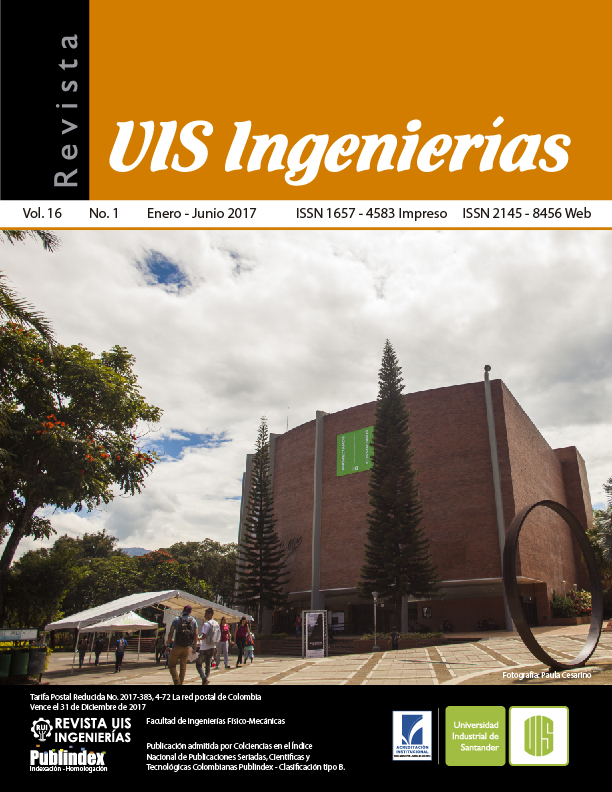Publicado 2016-12-30
Palabras clave
- ingeniería mecánica,
- simulación,
- XFEM,
- LSM,
- FMM
Cómo citar
Resumen
El level set method es una técnica que se utiliza habitualmente para describir matemáticamente la propagación de superficies mediante la aproximación y resolución de ecuaciones diferenciales. Esta técnica ha sido ampliamente utilizada en combinación con el XFEM, especialmente en el análisis del crecimento de grietas. Sin embargo, existen otras opciones que se basan en consideraciones geometricas como el fast marching method. En este trabajo se implementa una técnica geométrica basada en el fast marching method y level sets para la descripción de propagación de grietas en XFEM y, por tanto, compatible para su uso directo con esta técnica en cálculos de mecánica de la fractura.
Descargas
Referencias
- J. A. Sethian, Level Set Methods and Fast Marching Methods: Evolving Interfaces in Computational Geometry, Fluid Mechanics, Computer Vision and Materials Science, Cambridge University Press. Cambridge. R.U. 1999.
- J. A. Sethian, “Evolution, Implementation, and application of level set and fast marching methods for advancing fronts”, Journal of Computational Physics, vol. 169, pp. 503-555, 2001.
- J. A. Sethian, “A Fast Marching Level Set Method for Monotonically Advancing Fronts”, Proc. Nat. Acad, vol. 93, nº. 4, pp.1591-1595, 1996.
- J. A. Sethian, “Fast marching methods”, Society of Industrial and Applied Math.. Review, vol 41, nº 2, pp. 199-235,1999.
- T. J. Barth, J.A. Sethian, ”Numerical schemes for the Hamilton-Jacobi and level set equations on triangulated domains”, Journal of Computational Physics. 1998, vol. 145, pp. 1-40, 1998.
- N. Moës, J. Dolbow, T. Belytschko, “A Finite Element Method for Crack Growth Without Remeshing”, International Journal for Numerical Methods in Engineering, vol. 46, nº 1, pp. 131-150, 1999.
- M. Stolarska, D. Chopp, N. Moës, T. Belytschko, “Modelling crack growth by level sets in the extended finite element method”, International Journal for Numerical Methods in Engineering, vol. 51, pp. 943-960, 2001.
- N. Moës, A. Gravouil, T. Belytschko, “Non-planar 3D crack growth by the extended finite element and level sets-part I mechanical model”, International Journal for Numerical Methods in Engineering, vol. 53, pp. 2549-2568, 2002.
- A. Gravouil, N. Moës, T. Belytschko, “Non-planar 3D crack growth by the extended finite element and level sets-part II: Level set update”, International Journal for Numerical Methods in Engineering, vol. 53, pp 2569-2586, 2002.
- M. Duflot, “A study of the representation of cracks with level sets”, International Journal for Numerical Methods in Engineering, vol. 70, nº11, pp. 1261-1302, 2006.
- N. Sukumar, D. L. Chopp, B. Moran, “Extended finite element method and fast marching method for three-dimensional fatigue crack propagation”, Engineering Fracture Mechanics, vol.70, pp. 29-48, 2003.
- D. L. Chopp, N. Sukumar, ”Fatigue crack propagation of multiple coplanar cracks with the coupled extended finite element / fast marching method”, International Journal of Engineering Science, vol. 41, pp. 845-869, 2003.
- N. Sukumar, D. L Chopp, E. Béchet, N. Moës, “Three- dimensional non-planar crack growth by a coupled extended finite element and fast marching method“, International Journal for Numerical Methods in Engineering, vol. 76, pp. 727-748, 2008.
- R. Kimmel, J. A. Sethian, “Computing geodesic paths on manifolds”, Proceedings of the national academy of Sciences , vol 95, nº15, pp.8431-8435, 1998.
- J. A. Sethian, A. Vladimirsky, “Fast methods for the eikonal and related Hamilton-Jacobi equations on unstructured meshes”, Proceedings of the National Academy of Sciences, vol. 97, nº 11, pp. 5699-5703, 2000.
- D. L. Chopp, ”Some improvements of the fast marching method”, Society of Industrial and Applied Math, vol. 23, nº1, pp 230-244, 2001.
- R. N. Elias, M. A. D. Martins, A. L. G. A. Coutinho, “Simple finite element-based computation of distance functions in unstructured grids”, International Journal for Numerical Methods in Engineering, vol.72, pp. 1095-1110, 2007.
- D. Adalsteinsson, J. A. Sethian, ”The fast construction velocities in level set methods”, The Journal of Computational Physics, vol. 148, pp. 2-22, 1999.

